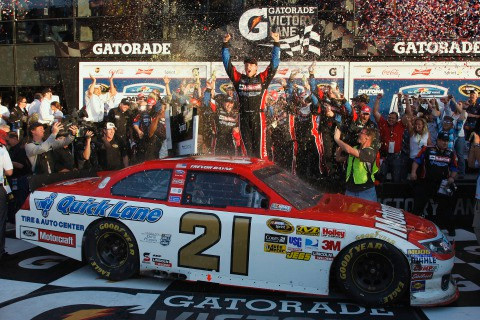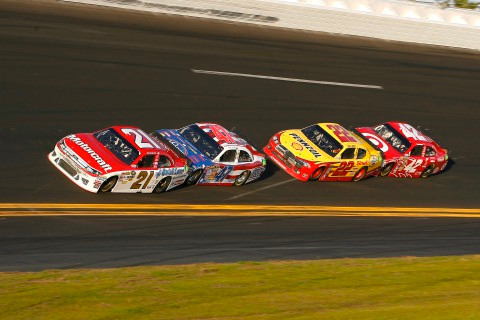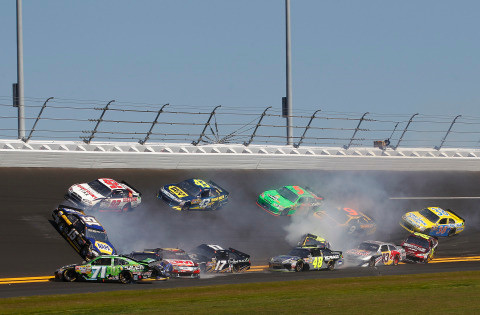The Way It is/ What would Big Bill and Bill Jr think?
by Gordon Kirby A shambolic, crash-filled Daytona 500 was saved by Trevor Bayne's superb Cinderella win in the Wood Brothers Ford. Bayne, 20, won NASCAR's biggest race in only his second Sprint Cup start providing the Wood Bros with their first win in ten years and first Daytona victory since David Pearson won back in 1976. So a very messy race was transformed into a celebration of the arrival of a talented new star and a return to the winner's circle of one of NASCAR's oldest and most venerated teams. A great day for NASCAR.
A shambolic, crash-filled Daytona 500 was saved by Trevor Bayne's superb Cinderella win in the Wood Brothers Ford. Bayne, 20, won NASCAR's biggest race in only his second Sprint Cup start providing the Wood Bros with their first win in ten years and first Daytona victory since David Pearson won back in 1976. So a very messy race was transformed into a celebration of the arrival of a talented new star and a return to the winner's circle of one of NASCAR's oldest and most venerated teams. A great day for NASCAR.
But when I watch a NASCAR race I often wonder what 'Big Bill' France and Bill Jr. would think about their sport if they were alive today. Somehow, I can't imagine either of NASCAR's two great dictators allowing stock car racing to become trapped amid the miasmic thinking that's resulted in the silly form of racing we witnessed at Daytona on Sunday and front page headlines 'Too safe at any speed?' on last Friday's USA Today. The story examined NASCAR's recent decline and suggested that an obsession with safety has contributed to Sprint Cup racing's fading appeal.
As NASCAR lost crowds and TV ratings over the past five years myriad changes, big and small, have been introduced by Brian France and his organization's post-Big Bill and Bill Jr. era bureaucracy. First, there was the much despised 'Car of Tomorrow', a contradiction in terms of course, which made all the cars equal but ugly and cast aside the veneer of the essential battle between manufacturers that has always driven NASCAR. Nobody from drivers to fans liked the CoT. It's been grudgingly accepted but many fans continue to say it's their primary complaint about Sprint Cup racing.

© LAT USA
This year NASCAR has made more changes and kept making them through last weekend. There's a new point system of course, the first big change in NASCAR's points payout in thirty years, while for the rest of the season the qualifying order will be determined by practice speeds rather than a draw. There's also a limit for the first time on the number of tires each car can use per race as well as a new self-venting fuel system that trims the over-the-wall crew from seven to six plus some changes to the front end and nose of the car with less of the splitter protruding. And after a recent switch to unleaded fuel NASCAR has adopted E15 ethanol this year while delaying the introduction of a McLaren fuel injection system until next year.
NASCAR likes to trumpet the value of its R&D operation in North Carolina where the CoT was developed. The R&D center produces NASCAR's techical changes but at Daytona last week the R&D division was made to look a little foolish when a new phenomenom materialized thanks to the ultra smooth new track surface and much increased grip.
The drivers discovered that two-car push-drafts could rocket them forward producing lap speeds over 200 mph and making a mockery of the theory of restrictor plate racing. Mid-week, NASCAR reduced the size of the front grille opening to 50 square inches and mandated a limit of 33 psi on the water radiator pressure relief valve so that the engines would get too hot to allow extended two-car drafts. The size of the restrictor plate was also cut by a further 1/64th of an inch and after Thursday's qualifying races the size of the radiator opening was increased slightly.
You can argue that NASCAR is caught in a box with its restrictor plate car. Whatever you do there's no way to win when you're working antithetically to the spirit of racing trying to slow-down the cars rather than make them faster. This game has been going on in motor racing for more than thirty years and taken to extremes like the Handford Wing in CART ten years ago and the katest version of restrictor plate racing it produces a show rather than a motor race in the traditional sense.
It's ironic of course that high-banked superspeedways were invented fifty years ago with Daytona as the prototype to increase speeds and make stock cars run faster at Daytona than Indy cars at the comparatively flat, four-cornered Indianapolis Motor Speedway.

© LAT USA
But Daytona's traditional season-opener remains quite healthy. Crowds are down from the heydays but continue to be pretty darn strong and surely will remain so. The week provides a great mid-winter break for many NASCAR fans and their families and is renowned as 'Red Neck High Holy Days', an event not to be missed.
But Daytona aside NASCAR has lost its pizazz. Many old time fans aren't interested anymore because the cars all look the same and because there are no Richard Pettys, David Pearsons or Dale Earnhardts to cheer for. NASCAR fans have made it clear in many polls that the drivers and sport as a whole have become too commercialized. The drivers have become pitchmen and marketeers rather than charismatic sports heroes and many fans of the wider sport ridicule NASCAR. A big segment of the auto racing market don't or won't watch NASCAR.
There have also been big losses among 18-34 males, the demographic most desired by the vast majority of sponsors. Many people worry that NASCAR must find ways to become relevant to the younger generation and to embrace changes in technology. But adopting new technology like four cylinder turbos or hybrid engines will be tough for NASCAR, witness the delay in going to fuel injection.
When I first went to a NASCAR race forty years ago it was immediately clear that the top teams--the Pettys, the Wood Brothers, Junior Johnson, et al.--were as good as the best road racers. In fact the more I looked at NASCAR the more I realized it was the most professional form of American racing. The cars were beautifully prepared and presented and the depth of the field was better than Indy car racing or any form of American road racing.

© LAT USA
So what would Big Bill and Bill Jr. say? Would they be happy with NASCAR spinning its wheels as it tries to consolidate its position? Would they accept its current role as a second tier sport and a marketing tool first and foremost that is belittled or ridiculed in many quarters.
But for many people NASCAR is a religion and the fan base remains much stronger than any other form of American racing. NASCAR reaches every corner and canyon of the United States and any other American sanctioning body would kill for NASCAR's comprehensive nationwide fan base and extensive ladder or farm system that keeps producing generations of young drivers (viz: Trevor Bayne, Joey Logano and David Ragan) and attracts thousands of hours of TV coverage. Sure NASCAR has its problems, but it's still a million miles ahead of every other form of racing in the United States.
Auto Racing ~ Gordon Kirby
Copyright 2011 ~ All Rights Reserved
Copyright 2011 ~ All Rights Reserved
Top of Page